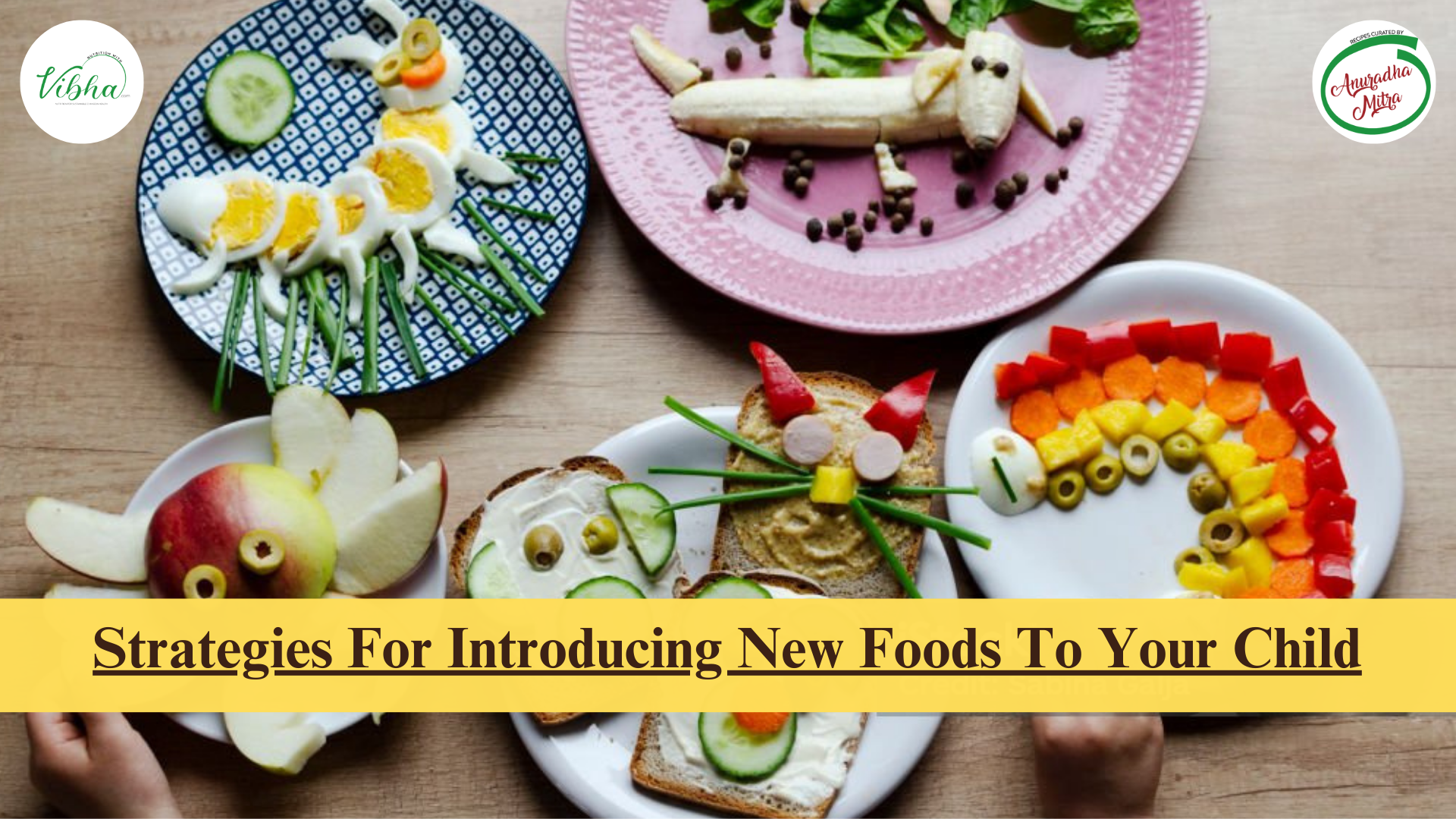Strategies for introducing new foods to your child – how to make healthy foods appealing to children.

Hello everyone! Do you ever feel like mealtime turns into a battleground when trying to introduce new foods to your kids? Let’s share some creative and fun strategies to make mealtimes more adventurous and less stressful for both us and our little ones!”
Let’s try to comprehend their special relationship with food. Let’s explore how you might approach the process with patience and creativity. By approaching mealtime with empathy and an open mind, you can empower your children. Your kids might grow up to have a broad palate and a lifelong love of healthful food.
As parents, you want to give your children the greatest start in life. Ensuring they eat balanced and nourishing food is an essential part of it. It is well-known that kids are picky eaters It might be difficult to encourage your child to try new foods, but doing so is crucial to helping them in forming healthy eating habits. This blog will provide you with practical strategies for gradually introducing new meals to children and developing a taste for healthy, nutritious foods by including them in meal planning and preparation, setting a positive example, offering new foods in a familiar way, offering a variety of foods, and not making them eat anything they don’t want to.
Kids are picky eaters; they love some foods that are generally well-liked among kids including pizza and chicken fingers. However, when it comes to other foods, they often don’t want to eat. Kids often decide they don’t like food even though they have never tried it.
Before you start using any new food introduction strategies, it’s important to understand your child’s opinion. Kids are naturally cautious of strange food at this age. For security and comfort, they largely rely on well-known flavours and textures. They could be reluctant to try new foods since their small taste receptors could be sensitive to strong flavours.
It’s crucial to handle situations involving a child who refuses to try new meals with kindness and tolerance.
Here are some simple suggestions to help your child gradually expand their culinary horizons:
- Set an example: Children often mimic the eating habits of those around them. If you encourage your toddler to try different foods, they might do the same. set a positive example for your children by eating different foods. Kids pick upon cues from their parents. your child is more likely to imitate you if they witness you experimenting with and enjoying various foods.
- Offer new foods in a familiar manner; kids could be unwilling to try new foods if they are offered in a unique way to have an unusual appearance. To make new meals seem more approachable, try serving them with or in a food that you are already familiar with. Try topping their plate with a small bit of mashed cauliflower if they are a big fan of mashed potatoes, for instance.
- Offer a variety of food: At very meal, provide a range of wholesome foods, such as fruits, vegetables, whole grains, and lean protein. By doing this, you may introduce your child to a wider range of flavours and textures and raise the likelihood that they will discover new foods they enjoy.
- Make it fun: Add games, storytelling, or themed dishes to make mealtimes an enjoyable journey. Adding a little imagination to the process can transform trying new meals from a terrifying activity to an exciting exploration.
- Give your kid options: Give your child some control over what they eat. Give them two or three options, one of which should be a new dish along with a few old favourites.
- Refrain from forcing your child to eat: Trying to force your child to try new meals will just make them more resistant. offer your child the new food instead, and let them choose whether or not to try it. Be persistent and patient; your child may need multiple exposures before showing interest in a new meal.
- Make it appealing: nutrient-rich examples:
- Colourful veggie sticks (carrots, cucumber, tomato) with curd.
- Plain yogurt with mixed Berries or mixed fruits.
- Presentation matters: Cut fruits and vegetables into fun shapes, and create colourful plates.
How do you encourage kids to taste different foods?
It takes skill to introduce new foods to your child’s diet. Every kid has a hard time trying new foods. Thus, introducing new meals to them suddenly could cause resistance. Rather, introduce new flavours and textures to them gradually:
Start small: Offer small portions of new foods with well-known ones to start. This allows your child to explore without feeling overwhelmed.
Repeat exposure: Studies indicate that a youngster May need to be exposed to a new food several times before they come to accept it. If your child initially refuses a new food, don’t give up. Continue reintroducing it in different ways.
How to introduce new foods to kids?
Here are creative and nutritious food ideas that are sure to captivate your kid’s imagination
Rainbow veggie skewers: make colourful, bite-sized kebabs by twisting coloured vegetables onto skewers. For addition appearance, serve with a side of yogurt dip.
Try these fruits and yogurt tarts! In a transparent glass, arrange pieces of different fruits layered with smooth yogurt to create a visually pleasing dessert that also serves as a nutritious snack.
DIY sandwich shapes: cut sandwiches into interesting shapes like hearts, stars, or animals with cookie cutters. Allow your child to participate by letting them select their favourite shapes.
Try offering veggies in different forms like raw with a dip, cooked into soups or sauces, or even blended into smoothies. Incorporate them into familiar dishes like adding finely chopped spinach to pasta sauce or sneaking grated carrots into muffins.
Incorporate vegetables in kids’ meals by making kid-friendly vegetable recipes-
- Vegetable pizzas
- Rainbow veggie skewers
- Veggie fried rice
- Vegetable pasta salad
- Incorporate vegetables in nuggets
- Sneak in some veggies in muffins
- Veggie wraps
The “Food Detective” Game:
- Present a new food in a mystery box or wrapped in a foil.
- Have your child use their senses, smell, touch, maybe even sound if its crunchy to guess what it might be.
- Unveil the food and let them try a bite, celebrating their detective skills.
“Build-your-own” Meals:
- let your child participate in the meal creation process.
- Set up stations with various ingredients-different types of wraps, veggies, sauces and let them create their own unique combinations.
“Dip It!” Fun:
- Even the pickiest eaters might open to a new food if they can dip it in something familiar and delicious.
- Offer a variety of healthy dips like hummus, yogurt-based dips, or sauces alongside new vegetables or fruits.
“Storytime Supper”:
- Pair new foods with stories or books that feature those ingredients
- For example, read Cloudy with a Chance of Meatballs” before serving a new vegetable dish.
- Get creative and make up your own silly food-related stories
Let kids play with their food, food on your child’s plate does not necessarily go into their mouth. If they move a vegetable around, pull it apart with their fingers, or sniff it, then they are at least getting more familiar with its look and feel.
Involve your child in meal planning and preparation:
- You can get your kids involved in meal preparation at home to get them to eat. Have them assist you in organizing the week’s menu.
- Take them shopping with you so you can choose your ingredients children who participate in meal preparation and planning are more likely to be open to eating new foods.
- Take your kids to the farmer’s market or grocery store and let them select some fruits and vegetables to sample.
- Involve children in meal preparation as well, such as slicing and cleaning veggies or stirring ingredients; this will encourage kids to try new foods. Allow kids to help in the kitchen; cute aprons may add excitement to them.
- To get your child into the habit of eating something different every day, don’t offer the same food two days in a row.
Start with small pieces – Try a single pea, one piece of fruit, or a crumble of paneer at home. Encourage your child with a saying “This is easy you could be done in a second”. Give your child food they enjoy after they have finished. Next, gradually phase out the follow-up food and increase the portion of the new item at the following meals.
You could also try introducing a food they love, alongside a new food to make trying something new less intimidating. Offer them their favourite muffins, for instance, and spread some strawberry jam- something they have never tried on top. They will be more likely to bite into that delicious muffin.
Scale back on snacks and drinks. Kids consuming more drinks every day are full because they fill up on liquids and don’t want to eat anything. Kids can also help assemble snack trays, which might get them interested in trying the foods. For instance, they can fill the bowl with dried fruit and other items. Just make sure that the items are cut into age-appropriate shapes.
Nourishing and Nutrient-Dense Food for young children
Breakfast: Mixed Berry Smoothie, Fruit salad, Spinach omelet.
Lunch– Veggie wraps, lentil soup, Chicken salad with Grapes.
Dinner – Chicken with roasted vegetables, stir-fry with Tofu and mixed vegetables, Pasta with white sauce and spinach.
Protein-
Choose lean sources- chicken, fish, Beans lentils, Tofu, Egg, Plain yogurt.
- Serve a variety- chicken skewers with grilled vegetables.
- Tuna salad sandwich on whole-wheat bread.
- Black beans burger with avocado.
Grains:
- Opt for whole grains.
- Whole-wheat bread, brown rice, oatmeal.
Pair with protein and vegetables:
- Chicken and vegetable stir-fry with Brown rice.
- Lentil soup with whole-wheat bread.
- Quinoa salad with chickpeas and vegetables.
Dairy-
- Choose low-fat or fat-free options- milk, yogurt, cheese.
- Incorporate into meals and snacks- cheese cubes with whole wheat crackers.
- Smoothies made with Milk, Yogurt, and Fruit.
- Healthy fats- include sources of unsaturated fats.
- Avocado, Nuts, Seeds, Olive oil.
Add to meals and snacks:
- Avocado toast on whole-wheat bread.
- Mix with Nuts, Seeds and Dried fruit.
- Salad with olive oil and Vinegar dressing.
There’s more to encouraging kids to try new meals than just broadening their palates. Establishing the foundation for a lifetime of wholesome eating practices is another goal. You may teach your children with gentle encouragement, creative thinking, and patience. This is a big start in the right direction -embracing a varied and nourishing diet. This can be achieved by taking into account their point of view, using cheerful methods, and introducing new meals gradually.
Above all, you instill in them a spirit of food exploration and adventure. You, as parents, have a significant influence on how your kids view food. You can encourage children to make better decisions as they become older by encouraging their sense of adventure. So, let’s set out on this adventure with passion and commitment. Additionally, keep in mind that each tiny step your toddler takes toward trying new foods represents an important developmental milestone. Working together, you may instill in children a lifelong appreciation for healthful meals.
At Nutrition with Vibha, we strongly think that behavior changes that might improve someone’s health over time can be mostly brought about by empowerment and education. In addition to this, we have produced some resources that educate and empower you regarding specific health issues.
Write to us if you would want access to our premium blogs. You can contact us and view our website at nutritionwithvibha.com. By doing this, you will be able to make much better dietary judgments. You can also send us an email at nutritionwithvibha@gmail.com if you have any requirements or would like to schedule a private session.
Stay Nourished
Stay Blessed





